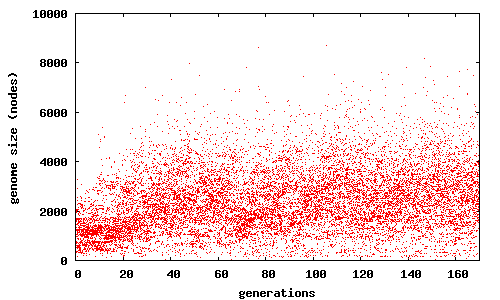As we approach 25,000 ratings we've noticed that the complexity of the music has not increased much lately. Looking at genome size vs. evolutionary time, we saw that we're hitting a technical limit that we imposed at the beginning of the experiment, namely that no individual genome tree should have more than 5000 nodes (a node is roughly equivalent to a nucleotide base in biology). This limit ensured that we had enough compute resources to keep four channels running simultaneously. (In the plot below, you can see individuals with more than 5000 nodes, but they were not allowed to reproduce.)

Five thousand nodes seemed like plenty at the time, and indeed we get some nice music out of the system thanks to everyone's participation. But now that the student channels are no longer running, we can afford to relax the size limit and see what happens. So from today, we have a 10,000 node limit on genome size. Will we get music which is doubly complex after another 10k ratings? Alternatively, will we find that the small population size (100 individuals) is a limiting factor? For something that is inherently so slow and incremental, this is really quite exciting. We can't wait to find out.
Comments
Not an anti-bloat measure
For all the genetic programming people out there, the 5000 nodes limit was not an anti-bloat measure. Indeed, we ran 50 generations under random selection and found that genome size overall tended to decrease (there were increases and decreases during the run).